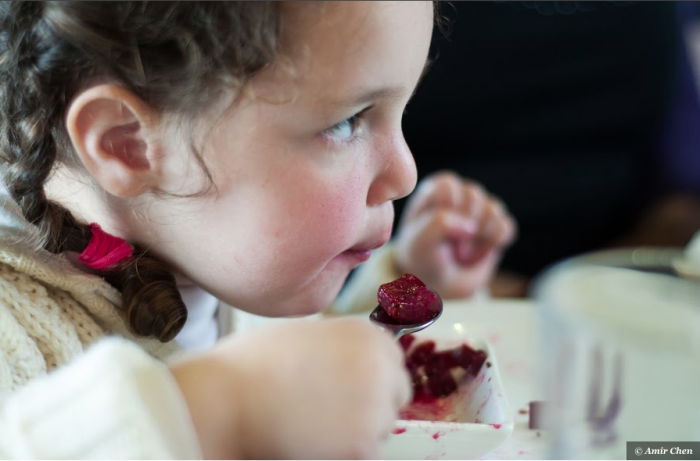*Authors Note: This article does not address allergies. Please use caution and follow what works best for your family.
A few years ago, my youngest child had a friend stay the night.
She was a sweet girl and they played well together, but her mom warned me she was really picky when it came to food. “Does she eat tacos?” I asked. “Yes, she does!” This was before I went vegan so this seemed easy enough.
Later that evening, I served up some homemade tacos and my daughter’s friend looked up at me with big eyes: “I only eat tacos from Taco Bell,” she said. “How about peanut butter and jelly?” I ask. “Okay, but only with white bread, creamy peanut butter and grape jelly,” she replied.
Sigh.
Do you have a picky eater? My children have never been extremely picky and I feel fortunate for that, especially after I went vegan. But I have a confession to make: I was a picky eater. I was not only picky—I was obsessively picky. For awhile as a child I required a different fork for each food group on my plate because I didn’t want anything to touch. My poor mother, I don’t know how she dealt with me.
Since I remember what it was like to be that picky eater, I have a few tips form a former child food snob.
Attitude is everything
Having food aversions as an adult is common. However, once we become parents many of us realize we want our kids to grow up eating healthy. In order to convince our children to eat this way, we need to model that behavior for them. This means serving up a variety of foods and trying them yourself.
If you aren’t sure you are going to like a certain food, try to taste it when the little ones aren’t around so they don’t see your reaction if you end up not liking it. Children are keen observers and they will notice if you are faking it. Keep an open mind and try food cooked in different ways and present it with a positive attitude.
Don’t force it
I have many memories of me sitting at the table dangling my legs back and forth for what seemed like hours after everyone in my family had already eaten and left the table. There I sat—food growing colder by the second—alone and my butt falling asleep. I did not want to eat that food and in a test of wills, my mother had told me to sit there until I ate. Little did she know that I have an extremely stubborn streak running through my veins and so I sat and sat and sat.
If you are a parent and considering attempting this method I must say: don’t! By pushing your child to do something he/she does not want to do, you have now created a bigger issue than we you had originally. Now it is a test of wills. Now it is this thing that is going to sit there and be a big deal.
Here is what I have done and it has worked so far. The deal is, I have asked my children to try what I cooked. They do not have to eat it if they don’t like it but they must try it. If they don’t like it, they are allowed (I realize this is going to cause some controversy with readers) to have a substitute meal that is a healthy alternative. They need to get this themselves now, but when they were younger I would get it. This could be peanut butter and jelly with apples or a small salad or something similar.
I understand that many families will not allow this. The idea is that children will possibly consistently turn down the dinner that is offered and go for the PB&J. But I must tell you, this has worked successfully for me. My children almost always eat what I make—vegetables and all.
Smoothies may be your best friend
If you can get your child to drink smoothies, this will be a wonderful tool for getting necessary vitamins and nutrients in to their growing bodies! If you haven’t tried this yet, I highly recommend it. Some professionals are not supportive smoothies and juicing because the theory is that it raises our sugar levels up quickly and doesn’t give our bodies time to produce digestive enzymes since it is goes straight to our stomachs.
The thing is, when we have picky eaters we are willing to try almost anything to get some healthy food in them. This has to be better than store-bought juice, anyway.
Start by making your smoothie with mostly fruit. Raspberries are great to add because they make the smoothie look inviting and taste great. Add maybe part of an orange and banana and (shhh) just a little bit of spinach. Why spinach? It’s virtually tasteless and the raspberries cover up the green coloring. (Unless your child likes green) Also spinach has a ton of vitamins in it.
Once your child gets used to smoothies you can experiment with kale, carrots, etc in the vitamin rice drinks to see what will go over and what won’t. Again, don’t push the issue. What I like to do is drink one myself and say “Want to taste?” or “Want me to give you some in a cup? It’s good!”
Snack Trays
I first learned about snack trays from Dr. William Sears. These are great for little ones and my children remember them fondly. The idea is to get a muffin tray (the kind with six large muffin holes) or any divided tray and put in a variety of finger foods. I mixed ours up with carrots, pretzels, cereal, raisins, pieces of celery, Craisins, cheese (pre-Vegan), and other varieties of food. Keep in mind, this isn’t a meal but since children tend to eat small amounts often it can be a great way to supplement their diets.
Obviously if your child is very small, this may not be a work-able option. It is also imperative to keep an eye on children snacking due to the possibility of choking, etc.
Praise, but don’t overdo it
So if the day comes when your picky eater suddenly decides to try a piece of broccoli, praise is definitely in order. However, depending on the child’s personality, he/she may not like parents making a big deal about this. For example this: “Kyle I’m glad you are trying something different. Thank you.” and not this: “Hey everyone look! Kyle is trying broccoli! Isn’t that great? Kyle never eats broccoli! I’m so surprised you are eating something different, Kyle! Wow!”
Does the second one seem like overkill? It is and I’ve been the receiver of that type of reaction (as an adult) and it’s not fun. As a matter of fact, for some people/children this type of attention can cause someone to avoid doing anything different in the future. Praise is great, but remember the more nonchalant you are about your child’s pickiness the less they will probably be picky.
Food should be fun. It should feel nourishing and comforting. Mealtimes should have great memories tied to them, not struggles. Give it time and most likely your child will come around. I finally did!
This is the 3rd in a series of articles on Mindful Parenting. See the others here:
Mindful Parenting: Harnessing the Ego.
Mindful Parenting: The Illusion of the Perfect Parent.
Love elephant and want to go steady?
Sign up for our (curated) daily and weekly newsletters!
Editor: Bryonie Wise
Photo credit: Amir Chen/Pixoto











Read 1 comment and reply